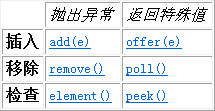1.Collection接口
Collection是java集合框架(collection-frame)中的顶层接口。Collection接口表示一个容器,容器中只能存储引用数据类型,建议存同一类型的引用类型,方便后续遍历等操作。
容器中的元素可以是有序的、可重复的,称为List接口;也可能是无序的、唯一的,称为Set接口。
Collection接口的常用方法:
1 public static void main(String[] args) { 2 3 /** 4 * 增:add/addAll 5 * 删:clear/remove/removeAll/retainAll 6 * 改: 7 * 查:contains/containsAll/isEmpty/size 8 */ 9 10 Collection c1 = new ArrayList(); 11 12 // 追加 13 c1.add("apple"); // Object object = new String("apple"); 14 // c1.add(1); // Object object = new Integer(1); 15 c1.add("banana"); 16 System.out.println(c1); 17 18 // 追加一个集合 19 Collection c2 = new ArrayList(); 20 c2.add("java"); 21 c2.add("c++"); 22 c1.addAll(c2); 23 System.out.println(c1); 24 25 // clear 26 //c1.clear(); 27 28 // c1.remove("apple"); 29 // c1.removeAll(c2); 30 //c1.retainAll(c2); 31 //System.out.println(c1); 32 33 System.out.println(c1.contains("apple")); 34 c2.add("js"); 35 System.out.println(c1.containsAll(c2)); 36 // c1.clear(); 37 System.out.println(c1.isEmpty()); 38 // 返回集合元素的个数 39 System.out.println(c1.size()); 40 41 System.out.println(c1.equals(c2)); 42 43 }
Collection接口的快速遍历:
1 // 快速遍历 2 // for-each 3 // Object 表示元素类型 4 // item表示迭代变量 5 // c1表示集合 6 for (Object item : c1) { 7 System.out.println(item.toString()); 8 }
快速遍历的本质:
Collection继承Iterable接口,表示集合支持快速遍历。Iterable接口定义了一个方法iterator()用于获取集合的迭代器,是一个Iterator接口类型,iterator()内部返回一个实现类实现类Iterator接口。这个实现类一定具有hasNext和next方法用于判断是否有下一个元素和获取下一个元素。快速遍历就是基于迭代器工作的。
1 public static void main(String[] args) { 2 3 4 Collection c1 = new ArrayList(); 5 c1.add("apple"); 6 c1.add("banana"); 7 c1.add("coco"); 8 9 10 // 快速遍历 11 // for-each 12 // Object 表示元素类型 13 // item表示迭代变量 14 // c1表示集合 15 for (Object item : c1) { 16 System.out.println(item.toString()); 17 } 18 19 // 迭代器遍历(国内) 20 Iterator it = c1.iterator(); 21 while(it.hasNext()) { 22 Object item = it.next(); 23 System.out.println(item.toString()); 24 } 25 26 // 国外 27 for(Iterator it2=c1.iterator();it2.hasNext();) { 28 Object item = it2.next(); 29 System.out.println(item.toString()); 30 } 31 }
2.List接口
List 接口中的元素时有序的、可重复的。List接口中的元素通过索引(index)来确定元素的顺序。
有序的 collection(也称为序列)。可以对列表中每个元素的插入位置进行精确地控制。用户可以根据元素的整数索引(在列表中的位置)访问元素,并搜索列表中的元素。
List接口的常用方法:
1 public static void main(String[] args) { 2 3 /** 4 * 增:add/addAll/add(index,el)/addAll(index,collection) 5 * 删:clear/remove/removeAll/remove(index) 6 * 改:set(index,el) 7 * 查:get(index)/indexOf/lastIndexOf() 8 * 其他:contains/containsAll/isEmpty/size 9 */ 10 List list1 = new ArrayList(); 11 // 添加元素 12 list1.add("apple"); 13 list1.add("banana"); 14 // 在指定位置添加元素 15 list1.add(0, "coco"); 16 17 System.out.println(list1); 18 19 List list2 = new ArrayList(); 20 list2.add("java"); 21 list2.add("c++"); 22 23 list1.addAll(1, list2); 24 System.out.println(list1); 25 26 // 删除 27 list1.remove(0); 28 System.out.println(list1); 29 30 // 修改 31 list1.set(0, "javax"); 32 System.out.println(list1); 33 34 // 查 35 System.out.println(list1.get(0)); 36 list1.add("apple"); 37 list1.add("apple"); 38 System.out.println(list1); 39 System.out.println(list1.indexOf("apple")); 40 System.out.println(list1.lastIndexOf("apple")); 41 }
List接口的遍历:
ListIterator 继承于Iterator,在Iterator的基础上提供了以正向遍历集合,也可以以逆序遍历集合。
hasNext/next 以正向遍历
hasPrevious/previous 以逆序遍历
1 public static void main(String[] args) { 2 3 4 List list1 = new ArrayList(); 5 list1.add("apple"); 6 list1.add("banana"); 7 list1.add("coco"); 8 9 // 【1】快速遍历 10 System.out.println("--for each--"); 11 for (Object item : list1) { 12 System.out.println(item.toString()); 13 } 14 15 // 【2】普通for 16 System.out.println("--for--"); 17 for(int i=0;i<list1.size();i++) { 18 System.out.println(list1.get(i)); 19 } 20 21 // 【3】集合迭代器 22 System.out.println("--iterator--"); 23 Iterator it = list1.iterator(); 24 while(it.hasNext()) { 25 System.out.println(it.next()); 26 } 27 28 System.out.println("--list iterator--"); 29 // 正向遍历 30 ListIterator it2 = list1.listIterator(); 31 while(it2.hasNext()) { 32 System.out.println(it2.next()); 33 } 34 35 // 逆序遍历 36 while(it2.hasPrevious()) { 37 System.out.println(it2.previous()); 38 } 39 40 System.out.println("--list iterator with index--"); 41 ListIterator it3 = list1.listIterator(1); 42 while(it3.hasNext()) { 43 System.out.println(it3.next()); 44 } 45 }
3.LinkedList接口
LinkedList是List接口的实现类,底层数据结构是链表。
LinekList常用方法和遍历方法参照List接口。
LinkedList 线程不安全。
除了实现List接口, 还实现栈接口。
push入栈操作 / pop出栈操作:

1 public class Test01 { 2 public static void main(String[] args) { 3 LinkedList list = new LinkedList(); 4 list.push("apple"); 5 list.push("banana"); 6 list.push("coco"); 7 8 9 System.out.println(list.pop()); 10 System.out.println(list.pop()); 11 System.out.println(list.pop()); 12 13 // java.util.NoSuchElementException 14 System.out.println(list.pop()); 15 } 16 }
队列(Queue)接口:

add/remove/element() 可能会出现NoSuchElementException异常
1 public static void main(String[] args) { 2 3 LinkedList queue = new LinkedList(); 4 // 入队 5 /** 6 * 队列头 队列尾 7 *<----- <----- 8 * [apple, banana, coco] 9 */ 10 queue.add("apple"); 11 queue.add("banana"); 12 queue.add("coco"); 13 System.out.println(queue); 14 15 // 出队 16 System.out.println(queue.remove()); 17 System.out.println(queue.remove()); 18 System.out.println(queue.remove()); 19 System.out.println(queue); 20 21 // java.util.NoSuchElementException 22 System.out.println(queue.remove()); 23 24 25 // 获取表头元素 26 System.out.println(queue.element()); 27 }
offer/poll/peek 可能会返回特殊值(null):
1 public static void main(String[] args) { 2 3 LinkedList queue = new LinkedList(); 4 // 入队 5 /** 6 * 队列头 队列尾 7 *<----- <----- 8 * [apple, banana, coco] 9 */ 10 queue.offer("apple"); 11 queue.offer("banana"); 12 queue.offer("coco"); 13 14 // 出队列 15 //System.out.println(queue.poll()); 16 //System.out.println(queue.poll()); 17 //System.out.println(queue.poll()); 18 System.out.println(queue); 19 20 //System.out.println(queue.poll()); 21 22 // 获取表头元素 23 System.out.println(queue.peek()); 24 25 }
双向队列(Deque)接口:

1 /** 2 * 以双向队列形式操作LinkedList 3 */ 4 public class Test04 { 5 public static void main(String[] args) { 6 7 LinkedList queue = new LinkedList(); 8 // 入队 9 /** 10 *<----- <----- 11 * [apple, banana, coco] 12 * ----> -----> 13 */ 14 15 queue.addFirst("apple"); 16 queue.addFirst("banana"); 17 queue.addFirst("coco"); 18 System.out.println(queue); 19 20 System.out.println(queue.removeLast()); 21 System.out.println(queue.removeFirst()); 22 System.out.println(queue.removeFirst()); 23 System.out.println(queue); 24 25 // 获取头元素 26 System.out.println(queue.getFirst()); 27 28 } 29 }